Leader-Member Exchange and Transformational Leadership: A Comparison
VerifiedAdded on 2023/04/04
|8
|1851
|390
Essay
AI Summary
This essay provides a comparative analysis of Leader-Member Exchange (LMX) and Transformational Leadership theories, exploring their impact on workforce participation, in-group/out-group dynamics, intelligence stimulation, work performance, and employee motivation. It highlights the advantages and disadvantages of each approach, noting how LMX fosters collaboration and motivation through employee involvement, while Transformational Leadership emphasizes individual task completion and leader-driven decision-making. The essay concludes that different leadership styles yield varying results, influencing organizational behaviors and overall productivity, with LMX promoting a more engaged and efficient workforce through active participation and strong leader-member relationships, in contrast to the more directive and potentially less motivating approach of Transformational Leadership. Desklib provides a platform to explore more solved assignments and study resources on leadership theories.

LEADERSHIP 1
Leadership
Student’s affiliate:
Institution affiliate:
Course:
Date:
Leadership
Student’s affiliate:
Institution affiliate:
Course:
Date:
Paraphrase This Document
Need a fresh take? Get an instant paraphrase of this document with our AI Paraphraser
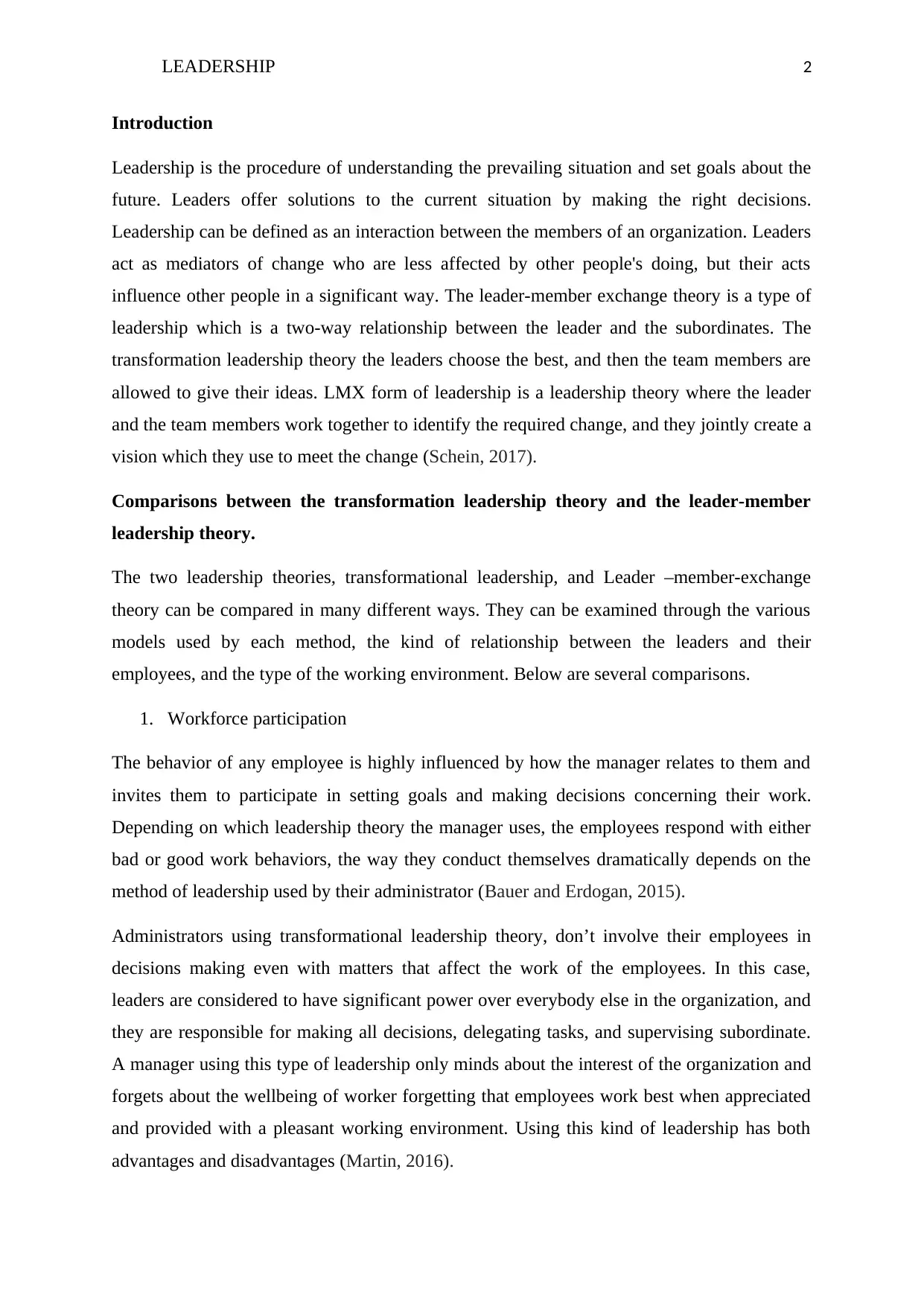
LEADERSHIP 2
Introduction
Leadership is the procedure of understanding the prevailing situation and set goals about the
future. Leaders offer solutions to the current situation by making the right decisions.
Leadership can be defined as an interaction between the members of an organization. Leaders
act as mediators of change who are less affected by other people's doing, but their acts
influence other people in a significant way. The leader-member exchange theory is a type of
leadership which is a two-way relationship between the leader and the subordinates. The
transformation leadership theory the leaders choose the best, and then the team members are
allowed to give their ideas. LMX form of leadership is a leadership theory where the leader
and the team members work together to identify the required change, and they jointly create a
vision which they use to meet the change (Schein, 2017).
Comparisons between the transformation leadership theory and the leader-member
leadership theory.
The two leadership theories, transformational leadership, and Leader –member-exchange
theory can be compared in many different ways. They can be examined through the various
models used by each method, the kind of relationship between the leaders and their
employees, and the type of the working environment. Below are several comparisons.
1. Workforce participation
The behavior of any employee is highly influenced by how the manager relates to them and
invites them to participate in setting goals and making decisions concerning their work.
Depending on which leadership theory the manager uses, the employees respond with either
bad or good work behaviors, the way they conduct themselves dramatically depends on the
method of leadership used by their administrator (Bauer and Erdogan, 2015).
Administrators using transformational leadership theory, don’t involve their employees in
decisions making even with matters that affect the work of the employees. In this case,
leaders are considered to have significant power over everybody else in the organization, and
they are responsible for making all decisions, delegating tasks, and supervising subordinate.
A manager using this type of leadership only minds about the interest of the organization and
forgets about the wellbeing of worker forgetting that employees work best when appreciated
and provided with a pleasant working environment. Using this kind of leadership has both
advantages and disadvantages (Martin, 2016).
Introduction
Leadership is the procedure of understanding the prevailing situation and set goals about the
future. Leaders offer solutions to the current situation by making the right decisions.
Leadership can be defined as an interaction between the members of an organization. Leaders
act as mediators of change who are less affected by other people's doing, but their acts
influence other people in a significant way. The leader-member exchange theory is a type of
leadership which is a two-way relationship between the leader and the subordinates. The
transformation leadership theory the leaders choose the best, and then the team members are
allowed to give their ideas. LMX form of leadership is a leadership theory where the leader
and the team members work together to identify the required change, and they jointly create a
vision which they use to meet the change (Schein, 2017).
Comparisons between the transformation leadership theory and the leader-member
leadership theory.
The two leadership theories, transformational leadership, and Leader –member-exchange
theory can be compared in many different ways. They can be examined through the various
models used by each method, the kind of relationship between the leaders and their
employees, and the type of the working environment. Below are several comparisons.
1. Workforce participation
The behavior of any employee is highly influenced by how the manager relates to them and
invites them to participate in setting goals and making decisions concerning their work.
Depending on which leadership theory the manager uses, the employees respond with either
bad or good work behaviors, the way they conduct themselves dramatically depends on the
method of leadership used by their administrator (Bauer and Erdogan, 2015).
Administrators using transformational leadership theory, don’t involve their employees in
decisions making even with matters that affect the work of the employees. In this case,
leaders are considered to have significant power over everybody else in the organization, and
they are responsible for making all decisions, delegating tasks, and supervising subordinate.
A manager using this type of leadership only minds about the interest of the organization and
forgets about the wellbeing of worker forgetting that employees work best when appreciated
and provided with a pleasant working environment. Using this kind of leadership has both
advantages and disadvantages (Martin, 2016).
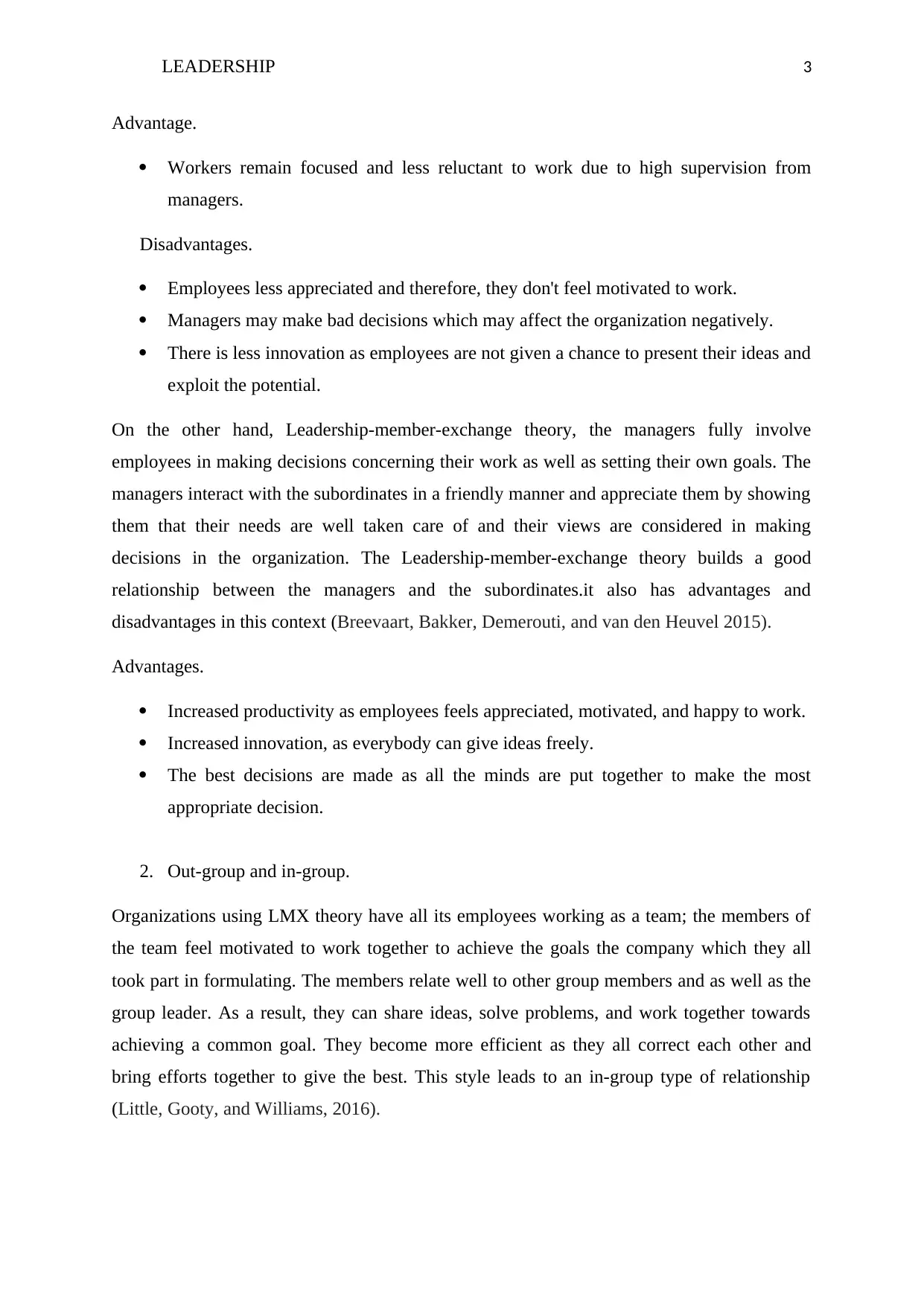
LEADERSHIP 3
Advantage.
Workers remain focused and less reluctant to work due to high supervision from
managers.
Disadvantages.
Employees less appreciated and therefore, they don't feel motivated to work.
Managers may make bad decisions which may affect the organization negatively.
There is less innovation as employees are not given a chance to present their ideas and
exploit the potential.
On the other hand, Leadership-member-exchange theory, the managers fully involve
employees in making decisions concerning their work as well as setting their own goals. The
managers interact with the subordinates in a friendly manner and appreciate them by showing
them that their needs are well taken care of and their views are considered in making
decisions in the organization. The Leadership-member-exchange theory builds a good
relationship between the managers and the subordinates.it also has advantages and
disadvantages in this context (Breevaart, Bakker, Demerouti, and van den Heuvel 2015).
Advantages.
Increased productivity as employees feels appreciated, motivated, and happy to work.
Increased innovation, as everybody can give ideas freely.
The best decisions are made as all the minds are put together to make the most
appropriate decision.
2. Out-group and in-group.
Organizations using LMX theory have all its employees working as a team; the members of
the team feel motivated to work together to achieve the goals the company which they all
took part in formulating. The members relate well to other group members and as well as the
group leader. As a result, they can share ideas, solve problems, and work together towards
achieving a common goal. They become more efficient as they all correct each other and
bring efforts together to give the best. This style leads to an in-group type of relationship
(Little, Gooty, and Williams, 2016).
Advantage.
Workers remain focused and less reluctant to work due to high supervision from
managers.
Disadvantages.
Employees less appreciated and therefore, they don't feel motivated to work.
Managers may make bad decisions which may affect the organization negatively.
There is less innovation as employees are not given a chance to present their ideas and
exploit the potential.
On the other hand, Leadership-member-exchange theory, the managers fully involve
employees in making decisions concerning their work as well as setting their own goals. The
managers interact with the subordinates in a friendly manner and appreciate them by showing
them that their needs are well taken care of and their views are considered in making
decisions in the organization. The Leadership-member-exchange theory builds a good
relationship between the managers and the subordinates.it also has advantages and
disadvantages in this context (Breevaart, Bakker, Demerouti, and van den Heuvel 2015).
Advantages.
Increased productivity as employees feels appreciated, motivated, and happy to work.
Increased innovation, as everybody can give ideas freely.
The best decisions are made as all the minds are put together to make the most
appropriate decision.
2. Out-group and in-group.
Organizations using LMX theory have all its employees working as a team; the members of
the team feel motivated to work together to achieve the goals the company which they all
took part in formulating. The members relate well to other group members and as well as the
group leader. As a result, they can share ideas, solve problems, and work together towards
achieving a common goal. They become more efficient as they all correct each other and
bring efforts together to give the best. This style leads to an in-group type of relationship
(Little, Gooty, and Williams, 2016).
⊘ This is a preview!⊘
Do you want full access?
Subscribe today to unlock all pages.

Trusted by 1+ million students worldwide
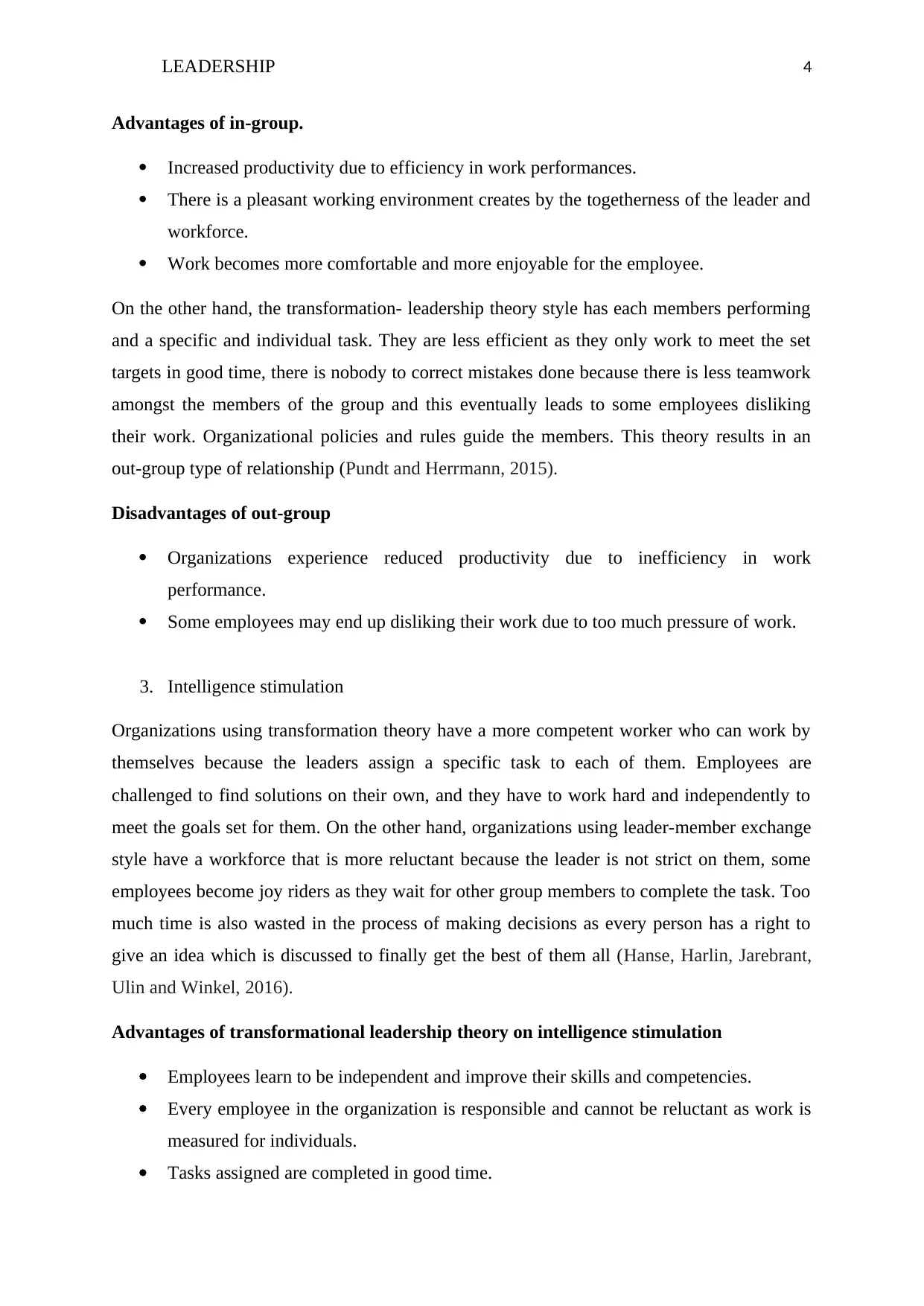
LEADERSHIP 4
Advantages of in-group.
Increased productivity due to efficiency in work performances.
There is a pleasant working environment creates by the togetherness of the leader and
workforce.
Work becomes more comfortable and more enjoyable for the employee.
On the other hand, the transformation- leadership theory style has each members performing
and a specific and individual task. They are less efficient as they only work to meet the set
targets in good time, there is nobody to correct mistakes done because there is less teamwork
amongst the members of the group and this eventually leads to some employees disliking
their work. Organizational policies and rules guide the members. This theory results in an
out-group type of relationship (Pundt and Herrmann, 2015).
Disadvantages of out-group
Organizations experience reduced productivity due to inefficiency in work
performance.
Some employees may end up disliking their work due to too much pressure of work.
3. Intelligence stimulation
Organizations using transformation theory have a more competent worker who can work by
themselves because the leaders assign a specific task to each of them. Employees are
challenged to find solutions on their own, and they have to work hard and independently to
meet the goals set for them. On the other hand, organizations using leader-member exchange
style have a workforce that is more reluctant because the leader is not strict on them, some
employees become joy riders as they wait for other group members to complete the task. Too
much time is also wasted in the process of making decisions as every person has a right to
give an idea which is discussed to finally get the best of them all (Hanse, Harlin, Jarebrant,
Ulin and Winkel, 2016).
Advantages of transformational leadership theory on intelligence stimulation
Employees learn to be independent and improve their skills and competencies.
Every employee in the organization is responsible and cannot be reluctant as work is
measured for individuals.
Tasks assigned are completed in good time.
Advantages of in-group.
Increased productivity due to efficiency in work performances.
There is a pleasant working environment creates by the togetherness of the leader and
workforce.
Work becomes more comfortable and more enjoyable for the employee.
On the other hand, the transformation- leadership theory style has each members performing
and a specific and individual task. They are less efficient as they only work to meet the set
targets in good time, there is nobody to correct mistakes done because there is less teamwork
amongst the members of the group and this eventually leads to some employees disliking
their work. Organizational policies and rules guide the members. This theory results in an
out-group type of relationship (Pundt and Herrmann, 2015).
Disadvantages of out-group
Organizations experience reduced productivity due to inefficiency in work
performance.
Some employees may end up disliking their work due to too much pressure of work.
3. Intelligence stimulation
Organizations using transformation theory have a more competent worker who can work by
themselves because the leaders assign a specific task to each of them. Employees are
challenged to find solutions on their own, and they have to work hard and independently to
meet the goals set for them. On the other hand, organizations using leader-member exchange
style have a workforce that is more reluctant because the leader is not strict on them, some
employees become joy riders as they wait for other group members to complete the task. Too
much time is also wasted in the process of making decisions as every person has a right to
give an idea which is discussed to finally get the best of them all (Hanse, Harlin, Jarebrant,
Ulin and Winkel, 2016).
Advantages of transformational leadership theory on intelligence stimulation
Employees learn to be independent and improve their skills and competencies.
Every employee in the organization is responsible and cannot be reluctant as work is
measured for individuals.
Tasks assigned are completed in good time.
Paraphrase This Document
Need a fresh take? Get an instant paraphrase of this document with our AI Paraphraser
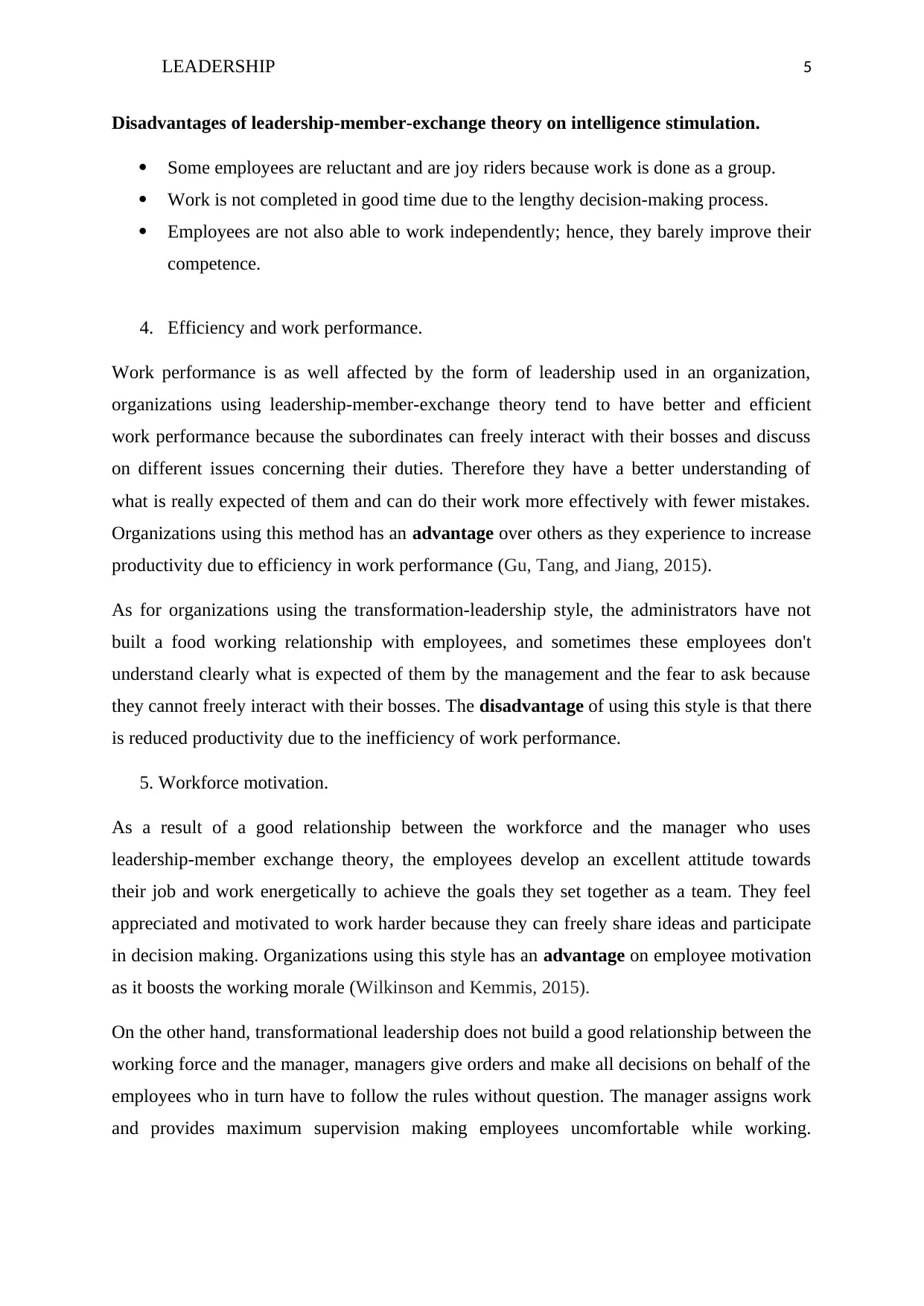
LEADERSHIP 5
Disadvantages of leadership-member-exchange theory on intelligence stimulation.
Some employees are reluctant and are joy riders because work is done as a group.
Work is not completed in good time due to the lengthy decision-making process.
Employees are not also able to work independently; hence, they barely improve their
competence.
4. Efficiency and work performance.
Work performance is as well affected by the form of leadership used in an organization,
organizations using leadership-member-exchange theory tend to have better and efficient
work performance because the subordinates can freely interact with their bosses and discuss
on different issues concerning their duties. Therefore they have a better understanding of
what is really expected of them and can do their work more effectively with fewer mistakes.
Organizations using this method has an advantage over others as they experience to increase
productivity due to efficiency in work performance (Gu, Tang, and Jiang, 2015).
As for organizations using the transformation-leadership style, the administrators have not
built a food working relationship with employees, and sometimes these employees don't
understand clearly what is expected of them by the management and the fear to ask because
they cannot freely interact with their bosses. The disadvantage of using this style is that there
is reduced productivity due to the inefficiency of work performance.
5. Workforce motivation.
As a result of a good relationship between the workforce and the manager who uses
leadership-member exchange theory, the employees develop an excellent attitude towards
their job and work energetically to achieve the goals they set together as a team. They feel
appreciated and motivated to work harder because they can freely share ideas and participate
in decision making. Organizations using this style has an advantage on employee motivation
as it boosts the working morale (Wilkinson and Kemmis, 2015).
On the other hand, transformational leadership does not build a good relationship between the
working force and the manager, managers give orders and make all decisions on behalf of the
employees who in turn have to follow the rules without question. The manager assigns work
and provides maximum supervision making employees uncomfortable while working.
Disadvantages of leadership-member-exchange theory on intelligence stimulation.
Some employees are reluctant and are joy riders because work is done as a group.
Work is not completed in good time due to the lengthy decision-making process.
Employees are not also able to work independently; hence, they barely improve their
competence.
4. Efficiency and work performance.
Work performance is as well affected by the form of leadership used in an organization,
organizations using leadership-member-exchange theory tend to have better and efficient
work performance because the subordinates can freely interact with their bosses and discuss
on different issues concerning their duties. Therefore they have a better understanding of
what is really expected of them and can do their work more effectively with fewer mistakes.
Organizations using this method has an advantage over others as they experience to increase
productivity due to efficiency in work performance (Gu, Tang, and Jiang, 2015).
As for organizations using the transformation-leadership style, the administrators have not
built a food working relationship with employees, and sometimes these employees don't
understand clearly what is expected of them by the management and the fear to ask because
they cannot freely interact with their bosses. The disadvantage of using this style is that there
is reduced productivity due to the inefficiency of work performance.
5. Workforce motivation.
As a result of a good relationship between the workforce and the manager who uses
leadership-member exchange theory, the employees develop an excellent attitude towards
their job and work energetically to achieve the goals they set together as a team. They feel
appreciated and motivated to work harder because they can freely share ideas and participate
in decision making. Organizations using this style has an advantage on employee motivation
as it boosts the working morale (Wilkinson and Kemmis, 2015).
On the other hand, transformational leadership does not build a good relationship between the
working force and the manager, managers give orders and make all decisions on behalf of the
employees who in turn have to follow the rules without question. The manager assigns work
and provides maximum supervision making employees uncomfortable while working.
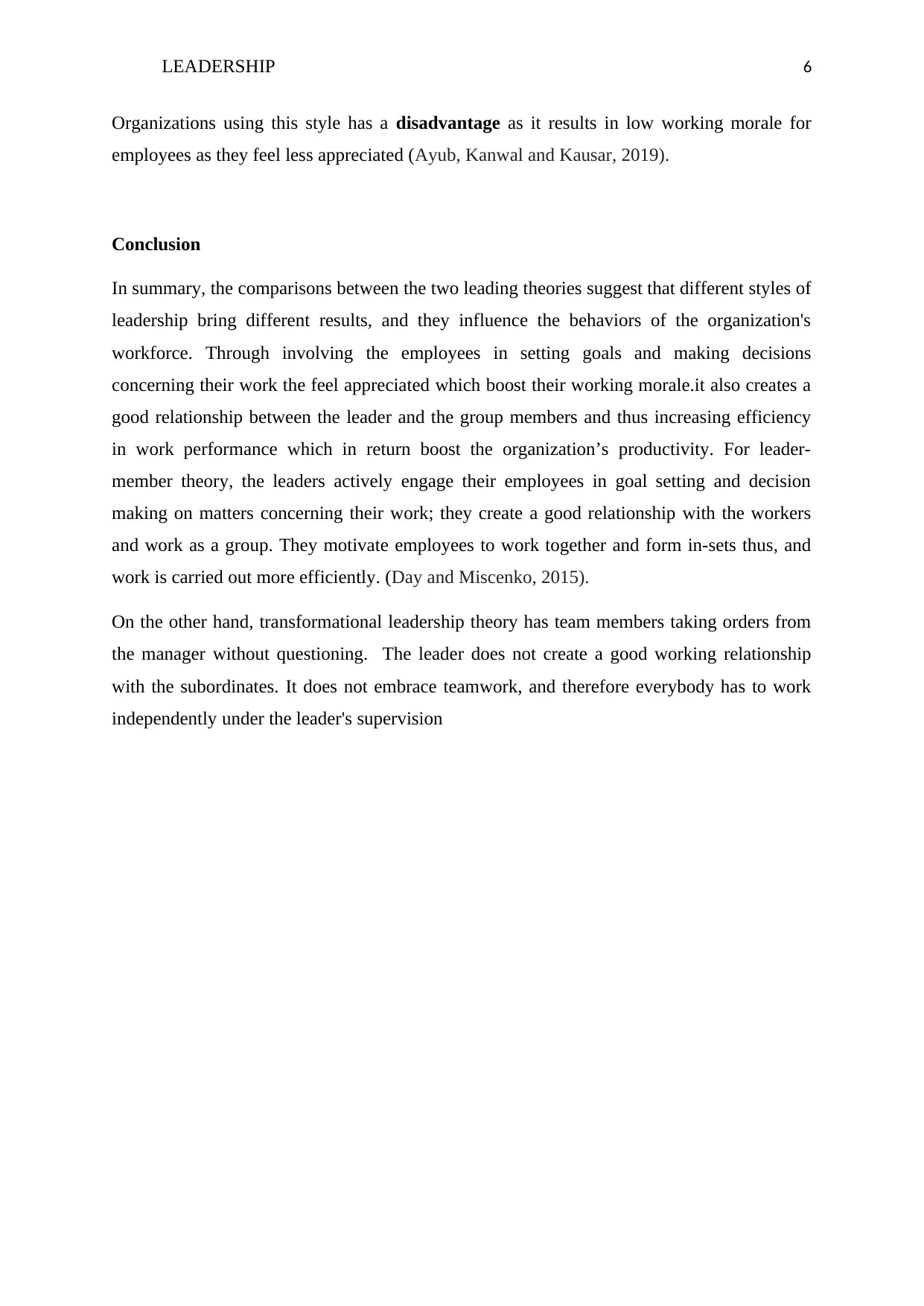
LEADERSHIP 6
Organizations using this style has a disadvantage as it results in low working morale for
employees as they feel less appreciated (Ayub, Kanwal and Kausar, 2019).
Conclusion
In summary, the comparisons between the two leading theories suggest that different styles of
leadership bring different results, and they influence the behaviors of the organization's
workforce. Through involving the employees in setting goals and making decisions
concerning their work the feel appreciated which boost their working morale.it also creates a
good relationship between the leader and the group members and thus increasing efficiency
in work performance which in return boost the organization’s productivity. For leader-
member theory, the leaders actively engage their employees in goal setting and decision
making on matters concerning their work; they create a good relationship with the workers
and work as a group. They motivate employees to work together and form in-sets thus, and
work is carried out more efficiently. (Day and Miscenko, 2015).
On the other hand, transformational leadership theory has team members taking orders from
the manager without questioning. The leader does not create a good working relationship
with the subordinates. It does not embrace teamwork, and therefore everybody has to work
independently under the leader's supervision
Organizations using this style has a disadvantage as it results in low working morale for
employees as they feel less appreciated (Ayub, Kanwal and Kausar, 2019).
Conclusion
In summary, the comparisons between the two leading theories suggest that different styles of
leadership bring different results, and they influence the behaviors of the organization's
workforce. Through involving the employees in setting goals and making decisions
concerning their work the feel appreciated which boost their working morale.it also creates a
good relationship between the leader and the group members and thus increasing efficiency
in work performance which in return boost the organization’s productivity. For leader-
member theory, the leaders actively engage their employees in goal setting and decision
making on matters concerning their work; they create a good relationship with the workers
and work as a group. They motivate employees to work together and form in-sets thus, and
work is carried out more efficiently. (Day and Miscenko, 2015).
On the other hand, transformational leadership theory has team members taking orders from
the manager without questioning. The leader does not create a good working relationship
with the subordinates. It does not embrace teamwork, and therefore everybody has to work
independently under the leader's supervision
⊘ This is a preview!⊘
Do you want full access?
Subscribe today to unlock all pages.

Trusted by 1+ million students worldwide
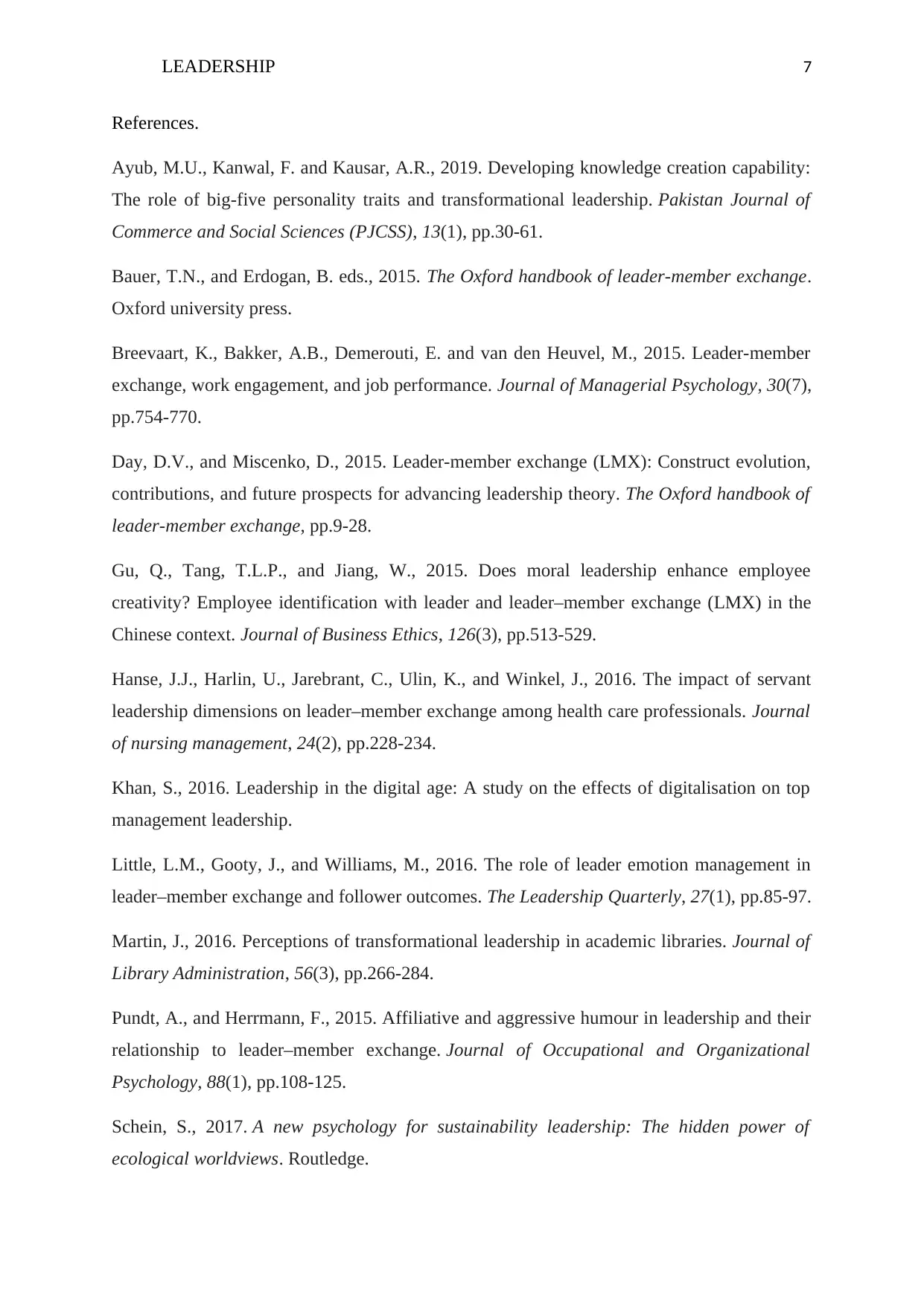
LEADERSHIP 7
References.
Ayub, M.U., Kanwal, F. and Kausar, A.R., 2019. Developing knowledge creation capability:
The role of big-five personality traits and transformational leadership. Pakistan Journal of
Commerce and Social Sciences (PJCSS), 13(1), pp.30-61.
Bauer, T.N., and Erdogan, B. eds., 2015. The Oxford handbook of leader-member exchange.
Oxford university press.
Breevaart, K., Bakker, A.B., Demerouti, E. and van den Heuvel, M., 2015. Leader-member
exchange, work engagement, and job performance. Journal of Managerial Psychology, 30(7),
pp.754-770.
Day, D.V., and Miscenko, D., 2015. Leader-member exchange (LMX): Construct evolution,
contributions, and future prospects for advancing leadership theory. The Oxford handbook of
leader-member exchange, pp.9-28.
Gu, Q., Tang, T.L.P., and Jiang, W., 2015. Does moral leadership enhance employee
creativity? Employee identification with leader and leader–member exchange (LMX) in the
Chinese context. Journal of Business Ethics, 126(3), pp.513-529.
Hanse, J.J., Harlin, U., Jarebrant, C., Ulin, K., and Winkel, J., 2016. The impact of servant
leadership dimensions on leader–member exchange among health care professionals. Journal
of nursing management, 24(2), pp.228-234.
Khan, S., 2016. Leadership in the digital age: A study on the effects of digitalisation on top
management leadership.
Little, L.M., Gooty, J., and Williams, M., 2016. The role of leader emotion management in
leader–member exchange and follower outcomes. The Leadership Quarterly, 27(1), pp.85-97.
Martin, J., 2016. Perceptions of transformational leadership in academic libraries. Journal of
Library Administration, 56(3), pp.266-284.
Pundt, A., and Herrmann, F., 2015. Affiliative and aggressive humour in leadership and their
relationship to leader–member exchange. Journal of Occupational and Organizational
Psychology, 88(1), pp.108-125.
Schein, S., 2017. A new psychology for sustainability leadership: The hidden power of
ecological worldviews. Routledge.
References.
Ayub, M.U., Kanwal, F. and Kausar, A.R., 2019. Developing knowledge creation capability:
The role of big-five personality traits and transformational leadership. Pakistan Journal of
Commerce and Social Sciences (PJCSS), 13(1), pp.30-61.
Bauer, T.N., and Erdogan, B. eds., 2015. The Oxford handbook of leader-member exchange.
Oxford university press.
Breevaart, K., Bakker, A.B., Demerouti, E. and van den Heuvel, M., 2015. Leader-member
exchange, work engagement, and job performance. Journal of Managerial Psychology, 30(7),
pp.754-770.
Day, D.V., and Miscenko, D., 2015. Leader-member exchange (LMX): Construct evolution,
contributions, and future prospects for advancing leadership theory. The Oxford handbook of
leader-member exchange, pp.9-28.
Gu, Q., Tang, T.L.P., and Jiang, W., 2015. Does moral leadership enhance employee
creativity? Employee identification with leader and leader–member exchange (LMX) in the
Chinese context. Journal of Business Ethics, 126(3), pp.513-529.
Hanse, J.J., Harlin, U., Jarebrant, C., Ulin, K., and Winkel, J., 2016. The impact of servant
leadership dimensions on leader–member exchange among health care professionals. Journal
of nursing management, 24(2), pp.228-234.
Khan, S., 2016. Leadership in the digital age: A study on the effects of digitalisation on top
management leadership.
Little, L.M., Gooty, J., and Williams, M., 2016. The role of leader emotion management in
leader–member exchange and follower outcomes. The Leadership Quarterly, 27(1), pp.85-97.
Martin, J., 2016. Perceptions of transformational leadership in academic libraries. Journal of
Library Administration, 56(3), pp.266-284.
Pundt, A., and Herrmann, F., 2015. Affiliative and aggressive humour in leadership and their
relationship to leader–member exchange. Journal of Occupational and Organizational
Psychology, 88(1), pp.108-125.
Schein, S., 2017. A new psychology for sustainability leadership: The hidden power of
ecological worldviews. Routledge.
Paraphrase This Document
Need a fresh take? Get an instant paraphrase of this document with our AI Paraphraser
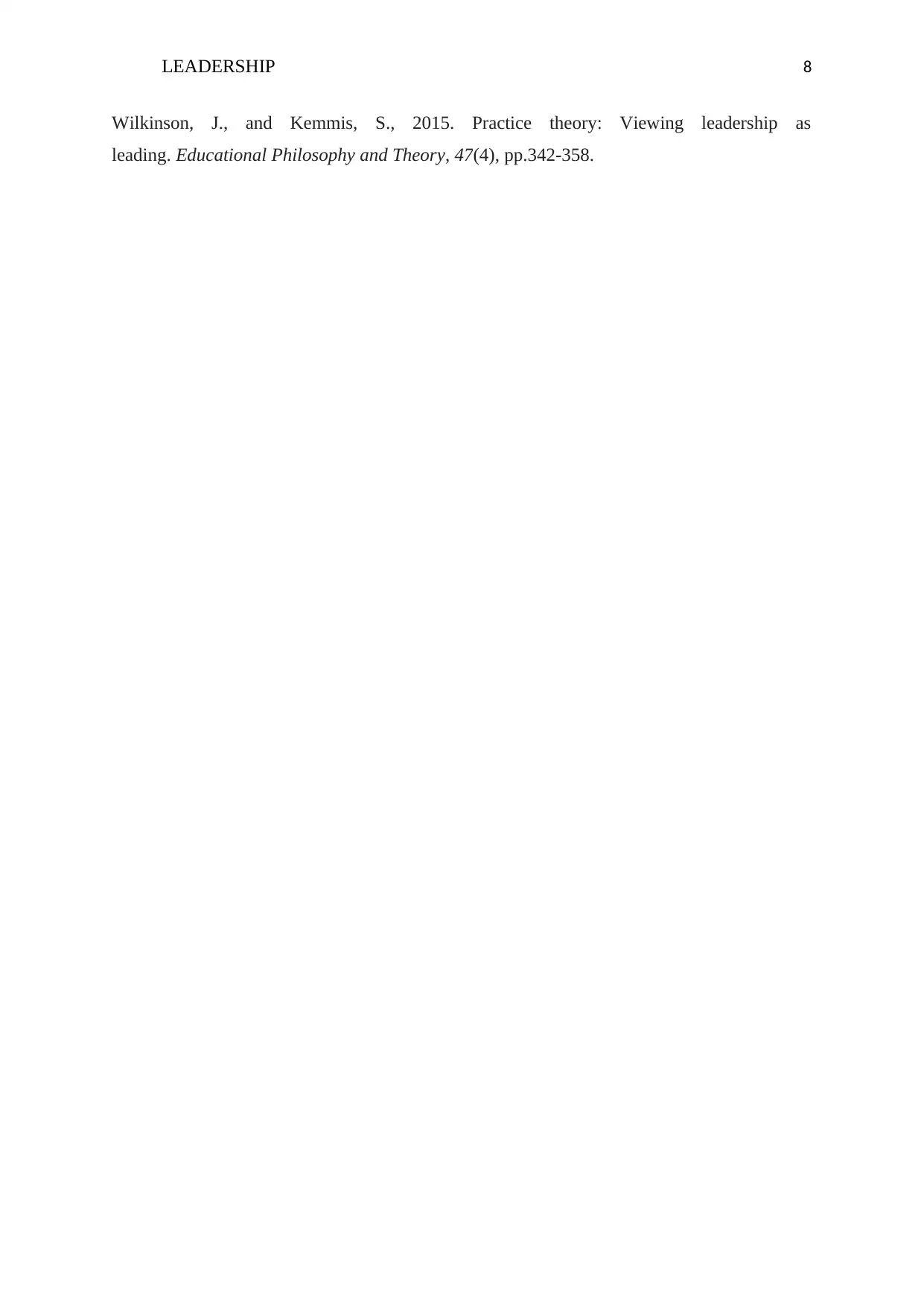
LEADERSHIP 8
Wilkinson, J., and Kemmis, S., 2015. Practice theory: Viewing leadership as
leading. Educational Philosophy and Theory, 47(4), pp.342-358.
Wilkinson, J., and Kemmis, S., 2015. Practice theory: Viewing leadership as
leading. Educational Philosophy and Theory, 47(4), pp.342-358.
1 out of 8
Related Documents
Your All-in-One AI-Powered Toolkit for Academic Success.
+13062052269
info@desklib.com
Available 24*7 on WhatsApp / Email
![[object Object]](/_next/static/media/star-bottom.7253800d.svg)
Unlock your academic potential
Copyright © 2020–2025 A2Z Services. All Rights Reserved. Developed and managed by ZUCOL.





